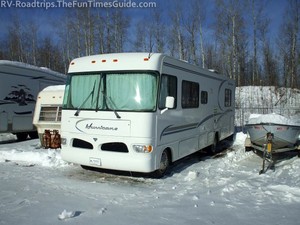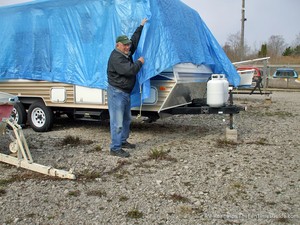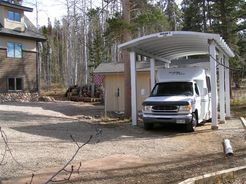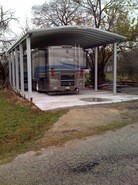 Before you know it, winter will be here and your options will boil down to 2 choices:
Before you know it, winter will be here and your options will boil down to 2 choices:
- Move into your RV and head south with the thousands of other snowbirds.
- Decide where you’re going to store your RV for the winter.
There are many different RV storage options to consider.
Here are 4 of the best choices for your RV or motorhome…
Heated Garage
Obviously, the best option is to keep your RV in a heated garage during the winter months. This will keep all of the plastic components at the safest temperature and will protect the entire RV from damaging sun, wind, and snow.
This is a relatively easy option for those with folding tent trailer styles of RVs. They’re small and, when collapsed, they will easily fit inside most residential garages.
For the rest of us (which is most of us), the empty garage space alongside your SUV or pickup truck just isn’t big enough to fit the large RV that’s been in the driveway all summer.
Since the weight of winter snow can easily crush the roof of most RVs unless they’re under cover, and you probably don’t want to be climbing up on your RV’s slippery roof to shovel the snow off, if you have a large RV, then it’s time to consider other storage options.
Like these…
Steel Building
If you have the space (and financial ability) to have a steel paneled pole building constructed, it would protect your RV from the snow and wind — even though it’s unheated. At a cost of about $15,000 to $30,000, professionals will build a great structure for your RV. Most steel buildings are also available as do-it-yourself kits, and they cost considerably less money.
Another option is a steel carport that will protect your RV from the loads of snow which would otherwise gather on your RV’s roof. Metal carports are open on the ends and have a sloped roof that allows snow to slide off, rather than building up on your motorhome or RV trailer.
Enclosed RV Storage Facility
For those without the space required for a protective structure like those mentioned above, you can rent space at a storage facility near you.
There are few things to consider when making use of such a storage place:
#1 Up north where winter can last for 6 months, once you’ve placed your RV in storage it is stuck there until the agreed upon release date. RVs and other vehicles are squeezed in — with mere inches between them — in order to maximize the number of vehicles stored in the building.
#2 Be sure to check with the storage facility as to what their insurance will or won’t cover. During years of unusually heavy snow accumulation here in Minnesota, it’s not uncommon for an occasional structure to fail, crushing the RVs or boats stored inside. It’s wise to keep your comprehensive insurance active and in place during times of storage to protect your investment from being damaged — either by nature or carelessness of a storage company.
#3 Rates for indoor storage are determined by the length of your RV. Most places charge by the foot — with the monthly rate ranging from $50 to into the hundreds. It all depends on the amenities, whether the space is heated or not, whether you will have access to your RV whenever you want, and whether you can work on or clean your RV while it’s in storage.
Outdoor Storage Facility
 Another popular option for RVers is to store their RV outdoors at a local facility. Your RV will be lined up alongside others, left to face the winter months outside. Rates here in Minnesota start as low as $25 a month (because not much more than a parking spot is provided).
Another popular option for RVers is to store their RV outdoors at a local facility. Your RV will be lined up alongside others, left to face the winter months outside. Rates here in Minnesota start as low as $25 a month (because not much more than a parking spot is provided).
Many times, parking is on a gravel lot without the benefit of blacktop to prevent moisture from creating rust on the RV’s undercarriage.
Outdoor storage facilities accept no responsibility for your RV while it is parked on their property. The potential for damage from vandals is much higher.
A few things to keep in mind when considering an outdoor storage facility are:
- Is there personnel on duty during regular business hours?
- Is the lot protected by a high fence with barbed wire?
- Will you have easy access to your RV?
- Is the area well lit and patrolled regularly?
My travel trailer is stored in this type of facility. I live in a mobile home community which has a couple onsite storage areas that are surround by a high fence and locked around the clock. The only people with access are other community members who have their boats or RVs stored inside the fence.
I’m comfortable with the arrangement, since my trailer is very close by and within the gated community. Making use of a similar place on the wrong side of the railroad tracks could be a lot riskier.
Don’t go into such a place without asking questions, and always keep your insurance current.
Self-
serve storage facilities will pretty much ignore it and expect the monthly check. It’s up to you to cover and monitor your RV throughout the winter. If it gets damaged, you probably won’t know about it until you go to get it.
You get what you pay for. If you invest in high-quality RV storage, your RV will look new for a long time to come. If you park it on the grass in your backyard, moisture will take its toll rather quickly and your RV will begin to deteriorate. And if you don’t remember to shovel the snow off the roof, you could have serious structural damage by spring!
Don’t forget to winterize your RV before you park it for the winter.
More About Outdoor & Indoor RV Storage





